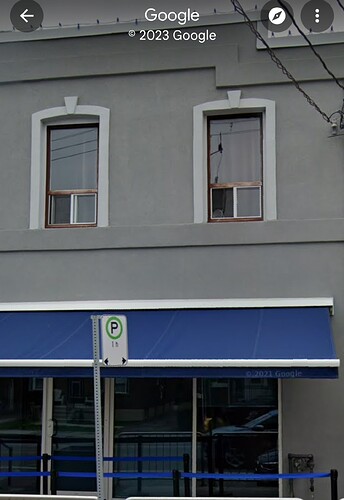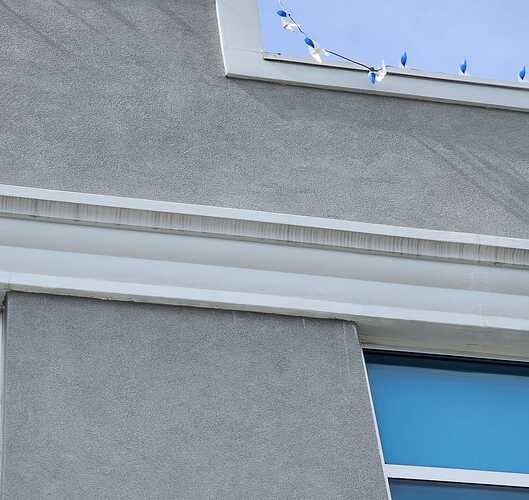Hi everyone, first time poster long time creeper here. I’m just starting off in the industry and waiting for things to thaw out up here in Canada before the busy season. I do have an opportunity on Monday which I’m super excited for but wanted to ask you all just to make sure I get it right and I’m not hit with a lawsuit day 1.
I have a building (pictures attached) that I was going to softwash with my xjet.
I’ve learned a lot from everyone here so I’m able to figure out my predilution for the xjet and all that but wanted to post a quick picture and walkthrough. Please correct me if I’m wrong in any step.
From all my research I’ve found that both stucco and awnings should be okay with about a 3% SH mix? As per @squidskc So just prewet everything to knock off any loose stuff then spray it all down with SH from the xjet. About a 5-7 min dwell time all around since we’re at about 5 degrees (40 F°). Make sure to agitate the awnings even though they seem pretty clean. And then rinse off. Work in chunks so it doesn’t dry anywhere.
I’m also going to surface clean the sidewalk which is concrete with again a 3% prewash mix.
Does this seem about right or am I oversimplfying by using 3% on the whole job? The mixing up and down on the fly freaks me out a little still. Any suggestions (I will test spot a few places to make sure we are okay). In addition are the windows okay with me getting 3% on them? What precautions should I take otherwise?
Any other wisdom would be most greatly appreciated!!!
And thanks to everyone that I’ve learned from. There are too many of you to thank!
-Tim
Welcome to the board.
I’ll be honest with you, it doesn’t look dirty at all to me in the pic, you probably won’t have to use more than 1%.
1 Like
1% on the awnings and stucco and then 3% on the concrete (sorry no pics for the concrete).? Do I have to worry about the SH strength on glass at all or does it not affect glass?
Not busting your chops, but if you are starting in the business you may want to do some more research. More importantly, other than does Sh affect glass, what is around the glass? Is it wood, vinyl, metal, brick? What kind of paint is that, SW? Looks like it is along the roadside on a pedestrian walkway, can you block off foot traffic? What happens if overspray gets on a car? Do you need a permit in that town/city? What about the chems, can they go in the gutter or do you need reclamation? Can you work at night and do you have lights? IS there special insurance needed?
2 Likes
It’s metal around the windows, it is along a roadside and yes I can block off foot traffic, as for cars, I’ve modified my gun to minimize overspray and won’t be using much pressure - overspray should be minimal - cars are a bit away and would a 3% mist hurt cars? I have a reclamation system in that will be used. I have insurance, and we will work during the day. All great points to make though. I appreciate it.
1 Like
Ok, I wash houses and buildings with windows, they all get SH all over them. SH is corrosive. Some paints react to SH, others don’t care. Test spot first. Some metals may not like SH to dwell on them long, especially certain finishes Rinsing before drying is mandatory. I think most horror stories have used one restore or something similar on those metals. There are a few of those stories on here. I would pack something just in case. Mitigating risks is a standard operating procedure for me.
Yea the rust around the windows makes me nervous. But ill be sure to run water on those as I’m working to dilute further.
I’m confused is one restore what caused the problem or what was used to fix them?
One Restore is great stuff but dangerous on metals.
1 Like
Sorry, was doing a quick reply. There was a posting on here of some people cleaning a Sherwin Williams and the metal reacted poorly, they needed another chem to fix the window frames and door. Thought they used that or maybe HD britenol, but can’t remember. The point is that you have to see what you are doing and then take precautions for yourself.
Dilution is not the same as neutralizing. You will hear that dilution is the solution on here, do what you want to with that.
If you accidently get overspray on somebody’s car, normally hosing it off is ok, but be prepared to have it detailed. I knock on neighbors doors or I talk to people leaving their cars to get permission to hose down and/or hose off their cars. Some people have elaborate wax jobs on their cars and very anal methods of water removal. Those people will be suing you or asking for you to pay to have their car waxed and clay barred and dryed off by a supermodel in a bikini. Just saying. Also, don’t be surprised when you start working the number of people that will purposefully park as close to the jobsite as they can. They know what they are doing. It is almost like running onto the metro bus after the accident.
Thanks for the breakdown. Ah ■■■■! I’d keep the supermodel and ditch the car anyway (same amount of maintenence). But points all taken. Thanks for the advice. My last question would be what can I do to protect the metal trim and prevent tiger stripes? I’m on the way to find some neutralizer as we speak. 3rd pool store and no one has any. But I’ll make sure to have some on hand. Here in the great white north the amazing chemicals are hard to come by.
Hi all, here is a follow up for anyone curious. I found that my 2-3% mix didn’t do very much - the building was pretty clean to begin with as suggested by @dcbrock. I avoided the mural on the side of the building just in case (sprayed a little test spray and it seemed like it wouldn’t do any damage but I thought I’d be extra cautious). The awnings didn’t seem to blink at the 3% mix which is also good news. Kept everything wet and got no complaints which is a good thing. I found that client was most impressed with the surface cleaning for the sidewalks and dumpster pads as well as the the double eagle and barc I used.
All in all quite a successful job, the only thing I wish I couldn’t done different was figure out how to get rid of the following tiger striping on the white stucco. It was there prior to and after I finished my job which leaves me to believe it was potentially dirt that streaks with rainfall?
Anyway, thank you everyone for all your help!
-Tim
Tiger stripes are basically electrostatically applied dirt from rainwater. On gutters it takes a strong butyl based chem but not sure about stucco.



